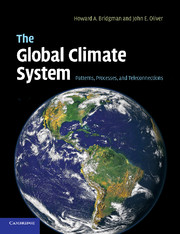Book contents
- Frontmatter
- Contents
- List of contributors
- Preface
- List of abbreviations
- 1 Introduction
- 2 Oscillations and teleconnections
- 3 Tropical climates
- 4 Middle-latitude climates
- 5 Climate of the polar realms
- 6 Post-glacial climatic change and variability
- 7 Urban impacts on climate
- 8 Human response to climate change
- 9 ESSAY: Model interpretation of climate signals: an application to Asian monsoon climate (Lau)
- 10 Conclusions and the future of climate research
- Other books on climatology and the climate system
- Index
- Plate section
- References
1 - Introduction
Published online by Cambridge University Press: 05 June 2012
- Frontmatter
- Contents
- List of contributors
- Preface
- List of abbreviations
- 1 Introduction
- 2 Oscillations and teleconnections
- 3 Tropical climates
- 4 Middle-latitude climates
- 5 Climate of the polar realms
- 6 Post-glacial climatic change and variability
- 7 Urban impacts on climate
- 8 Human response to climate change
- 9 ESSAY: Model interpretation of climate signals: an application to Asian monsoon climate (Lau)
- 10 Conclusions and the future of climate research
- Other books on climatology and the climate system
- Index
- Plate section
- References
Summary
The climate system
Climate is a function not only of the atmosphere but is rather the response to linkages and couplings between the atmosphere, the hydrosphere, the biosphere, and the geosphere. Each of these realms influences any prevailing climate and changes in any one can lead to changes in another. Figure 1.1 provides in schematic form the major couplings between the various components of the climate system. A climate-systems approach avoids the isolation of considering only individual climatic or atmospheric components. This approach recognizes the importance of forcing factors, which create changes on scales from long-term transitional to short-term sudden, and that the climate system is highly non-linear. According to Steffen (2001), a systems approach also recognizes the complex interaction between components, and links between the other great systems of the Earth, and the ways in which humans affect climate through the socioeconomic system. Ignoring such interactions may create inaccuracies and misinterpretations of climate system impacts at different spatial scales.
In examining any component of the Earth's atmosphere, its systems and its couplings, basic knowledge of the energy and mass budgets is critical. Information concerning these is given in most introductory texts (Oliver and Hidore 2002; Barry and Chorley 1998) and they are not reiterated in detail here. Rather, the following provides a brief summary of major concepts.
- Type
- Chapter
- Information
- The Global Climate SystemPatterns, Processes, and Teleconnections, pp. 1 - 24Publisher: Cambridge University PressPrint publication year: 2006



